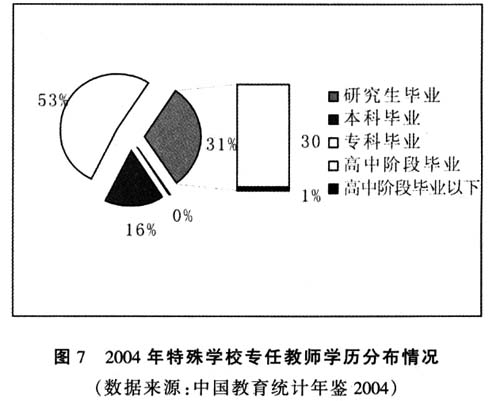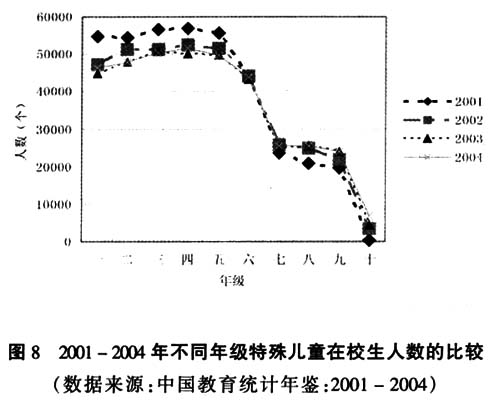首页 -> 2007年第2期
推进残疾儿童教育公平任重道远
作者:孟万金 刘在花 刘玉娟
尽管高学历教师的人数在教师总数中的百分比逐渐增多,但总的说来,特殊学校专任教师的学历结构还是存在问题,直至2004年,特殊教育学校专任教师中,研究生所占比例几乎为0,占主导地位的是专科毕业生,这种比例远远落后于普通义务教育中教师学历构成比。从最新的2004年的特教教师学历构成统计数据可略窥一斑(图7):

2.2.3 特教师资专业培训严重短缺,受过特教专业培训的教师仅占特殊学校专任教师的一半左右
根据《中国教育统计年鉴》,2004年特殊学校专任教师31058人,其中受过特教专业培训的教师为16310人,占特殊学校专任教师的52.5%。可见,特殊学校约一半专任教师没有受过特教专业培训,说明目前特教师资培训工作亟待开展。
3 残疾儿童教育结果的不公平现象
这里所讲的残疾儿童教育结果公平是指拥有同等的学业成功的机会、最终所获学历以及教育对日后生活的影响均等。义务教育是保底教育,其为学生提供的知识和能力的训练应该是所有人都能够达到的一个基本标准。义务教育后的职业教育属于发展性教育,旨在满足个体进一步发展的需要和社会对不同层次人才的需要。现实是,我国残疾儿童教育结果存在不公平现象。义务教育阶段,六年级以后残疾儿童在校生人数急剧下降,说明有相当一部分残疾儿童没有接受完基础知识和基本能力的训练。而由于残疾儿童中等职业教育发展非常薄弱,致使大部分儿童没有受到基本技能的训练,没有掌握一技之长,造成教育与就业之间的断层。
3.1 六年级以后特殊儿童在校生人数急剧下降
总体上讲,不同年级特殊儿童在校生人数分布情况类似,从一年级到五年级特殊儿童在校人数不断增加,六年级以后特殊儿童在校生人数呈急剧下降趋势,从40000多急剧下滑至20000多名。七年级是特殊儿童在校生人数分布的转折点,由此开始特殊学校儿童在校生人数逐渐减少,到十年级特殊儿童在校生人数最少(见表6、图8)。从某种意义上讲,与残疾儿童教育结果无出路、职业教育机会不充足、就业无出口有关。


3.2 残疾儿童中等职业教育发展非常薄弱
《中国残疾人事业“十五”计划纲要》明确指出特殊教育学校要“适应劳动力市场需求,大力开展残疾人职业教育。”[7]教育部在关于“十五”期间进一步推进特殊教育改革和发展的意见中也提出,要充分利用教育资源,发展残疾人高中阶段教育,坚持以职业教育为主,通过教育使学生具备良好的职业道德和比较熟练的职业技能,提高他们平等参与社会生活的能力[8]。根据《中国残疾人事业年鉴2006》的数字,截至2005年,我国有义务教育阶段的特教学校1662所,但是全国只有110所特教学校开办了中等职业教育,除此之外还有48所职业培训学校达到了中等专业水平[9]。根据《中国教育事业统计年鉴2004》的数字,我国当年残疾儿童毕业生为46727人,而所有特殊教育在校学生中职业技术班的学生仅有4751人。从数字对比可以看到,由于中等职业教育学校与班级较少,接受义务教育的残疾儿童中仅有少数残疾儿童能够继续接受职业教育,这就造成了残疾儿童教育与就业之间的断层,降低了残疾儿童就业的可能性。
参考文献
1 中华人民共和国义务教育法.1986年4月12日中华人民共和国主席令第38号公布
2 陈娉舒.我国每年新增0-6岁残疾儿童近20万.中国教育和科研计算机网.http://www.media.edu.cn/20031223/3096336.shtml,2003-12-23
3 中华人民共和国民政部. 中国1987年残疾人抽样调查资料提要. 北京:中国社会出版社,1991年12月
4 中华人民共和国民政部. 中国1987年残疾人抽样调查资料提要. 北京:中国社会出版社,1991年12月
5 唐万洁.走近徘徊于有声与无声之间的边缘人——关于随班就读后学生教育的若干思考.内部资料
6 蒋云尔.高等教育师范院校的办学定位.中国特殊教育,2004,7:91-94
7 中国残疾人事业“十五”计划纲要. http://www.cosn.net/htm/class/ordinance/2004-09-10905.htm,2004-09-12
8 赵小红.弱智学生职业教育研究概述.中国特殊教育,2004,1:28-32
9 残联发(2006)11号.中国残疾人事业“十五”计划纲要执行情况统计公报. http://temp.cdpj.cn/10thfive/2006-05/24/content_6414.htm,2006-05-22
There Is Still A Long Way to Go in Putting forward
Equity in Disabled Children Education
——The Fourth Comment on Equity in
Disabled Children Education
MENG Wanjin LIU Zaihua LIU Yujuan
(Department of Psychology and Special Education,
China National Institute for Educational Research, Beijing, 100088)
AbstractEquity in education includes equity in educational opportunity, educational process and educational outcome, while there are serious problems of disabled children education in the above three aspects. In the aspect of educational opportunity, compared with normal children, the enrollment rates of compulsory education and preschool education for disabled children are relatively low than those of normal children, while the rate of dropping out is higher than that of normal children. Even in the group of disabled children, different types and gender of disabled children and the economic development level of their hometown may influence their educational opportunities. In the aspect of educational process, the quality of learning in regular classes is relatively low, the quality of teachers in disabled children education is relatively low, and the quality of disabled children education can be hardly ensured. In the aspect of educational outcome, the number of disabled children who still stay in school above the sixth grade is decreasing rapidly. And the development of vocational education for disabled children is slow and weak, which forms the gap between education and employment. Therefore, there are still many challenges of equity in disabled children education in China, and we still have many responsibilities to fulfill.
Key wordsdisabled children equity in education process
(责任编校:单志艳)
[1]